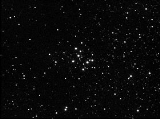
Messier 29
Encyclopedia
Messier 29 is an open cluster
in the Cygnus constellation. It was discovered by Charles Messier
in 1764, and can be seen from Earth
by using binoculars
.
M29 is a rather coarse and less impressive cluster, situated in the highly crowded area of Milky Way near Gamma Cygni
, at a distance of 7,200 (most sources including Mallas/Kreimer and Burnham, and agreeing with early estimates or R.J. Trumpler 1930) or 4,000 light years (the latter from Kenneth Glyn Jones and the Sky Catalogue 2000.0). The Night Sky Observer's Guide by Kepple and Sanner gives a deviating value of 6,000 light years - the uncertainty due to inaccurately known absorption of the cluster's light.
According to the Sky Catalog 2000, M29 is included in the Cygnus OB1 association, and approaching us at 28 km/sec. Its age is estimated at 10 million years, as its five hottest stars are all giants of spectral class B0. The Night Sky Observer's Guide gives the apparent brightness of the brightest star as 8.59 visual magnitudes. The absolute magnitude may be an impressive -8.2 mag, or a luminosity of 160,000 suns. The linear diameter was estimated at only 11 light years. Its Trumpler class is III,3,p,n (as it is associated with nebulosity), although Götz gives, differently, II,3,m, and Kepple/Sanner gives I,2,m,n. The Sky Catalogue 2000.0 lists it with 50 member stars; earlier Becvar gave only the number of 20 members.
This cluster can be seen in binoculars
. In telescopes, lowest powers are best. The brightest stars of M29 form a "stubby dipper", as Mallas says it. The four brightest stars form a quadrilateral, and another three, a triangle north of them. A few fainter stars are around them, but the cluster appears quite isolated, especially in smaller telescopes. In photographs, a large number of very faint Milky Way background stars shows up.
M29 can be found quite easily as it is about 1.7 degrees South and little East of Gamma or 37 Cygni (Sadr). In the vicinity of M29, there is some diffuse nebulosity which can be detected in photographs.
Open cluster
An open cluster is a group of up to a few thousand stars that were formed from the same giant molecular cloud and have roughly the same age. More than 1,100 open clusters have been discovered within the Milky Way Galaxy, and many more are thought to exist...
in the Cygnus constellation. It was discovered by Charles Messier
Charles Messier
Charles Messier was a French astronomer most notable for publishing an astronomical catalogue consisting of deep sky objects such as nebulae and star clusters that came to be known as the 110 "Messier objects"...
in 1764, and can be seen from Earth
Earth
Earth is the third planet from the Sun, and the densest and fifth-largest of the eight planets in the Solar System. It is also the largest of the Solar System's four terrestrial planets...
by using binoculars
Binoculars
Binoculars, field glasses or binocular telescopes are a pair of identical or mirror-symmetrical telescopes mounted side-by-side and aligned to point accurately in the same direction, allowing the viewer to use both eyes when viewing distant objects...
.
M29 is a rather coarse and less impressive cluster, situated in the highly crowded area of Milky Way near Gamma Cygni
Gamma Cygni
Gamma Cygni is a star in the constellation Cygnus. It has the traditional name Sadr ....
, at a distance of 7,200 (most sources including Mallas/Kreimer and Burnham, and agreeing with early estimates or R.J. Trumpler 1930) or 4,000 light years (the latter from Kenneth Glyn Jones and the Sky Catalogue 2000.0). The Night Sky Observer's Guide by Kepple and Sanner gives a deviating value of 6,000 light years - the uncertainty due to inaccurately known absorption of the cluster's light.
According to the Sky Catalog 2000, M29 is included in the Cygnus OB1 association, and approaching us at 28 km/sec. Its age is estimated at 10 million years, as its five hottest stars are all giants of spectral class B0. The Night Sky Observer's Guide gives the apparent brightness of the brightest star as 8.59 visual magnitudes. The absolute magnitude may be an impressive -8.2 mag, or a luminosity of 160,000 suns. The linear diameter was estimated at only 11 light years. Its Trumpler class is III,3,p,n (as it is associated with nebulosity), although Götz gives, differently, II,3,m, and Kepple/Sanner gives I,2,m,n. The Sky Catalogue 2000.0 lists it with 50 member stars; earlier Becvar gave only the number of 20 members.
This cluster can be seen in binoculars
Binoculars
Binoculars, field glasses or binocular telescopes are a pair of identical or mirror-symmetrical telescopes mounted side-by-side and aligned to point accurately in the same direction, allowing the viewer to use both eyes when viewing distant objects...
. In telescopes, lowest powers are best. The brightest stars of M29 form a "stubby dipper", as Mallas says it. The four brightest stars form a quadrilateral, and another three, a triangle north of them. A few fainter stars are around them, but the cluster appears quite isolated, especially in smaller telescopes. In photographs, a large number of very faint Milky Way background stars shows up.
M29 can be found quite easily as it is about 1.7 degrees South and little East of Gamma or 37 Cygni (Sadr). In the vicinity of M29, there is some diffuse nebulosity which can be detected in photographs.
External links
- Messier 29 LRGB image - 2 hrs total exposure
- Messier 29, SEDS Messier pages

